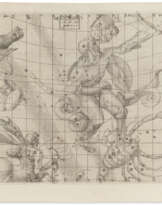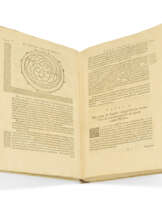ID 794513
Lot 168 | KEPLER, Johannes (1571-1630)
Estimate value
£ 25 000 – 35 000
Tabulae Rudolphinae, quibus astronomicae scientiae, temporum longinquitate collapsae restauratio continentur. Ulm: Jonas Saur, 1627.
First edition. ‘The chief vehicle for the recognition of his astronomical accomplishments’ (DSB); a handsome copy in a contemporary binding. On his deathbed in 1601, Tycho Brahe urged Kepler to complete his long-projected astronomical tables, to be based on Tycho's mass of observations and named after their patron Rudolph II. Kepler worked on these for years, with frequent interruptions. 'In excusing the long delay in publication [Kepler] mentioned in the preface not only the difficulties of obtaining his salary and of the wartime conditions but also ‘the novelty of my discoveries and the unexpected transfer of the whole of astronomy from fictitious circles to natural causes, which were most profound to investigate, difficult to explain, and difficult to calculate, since mine was the first attempt’ (DSB). The greatly improved accuracy of Kepler's tables over previous planetary tables was due in part to his discovery of the laws of planetary motion, but also to the 'happy calamity', as he put it, of his initiation into Napier's logarithms. Kepler created his own logarithmic tables (published in 1624), and used them for the complex calculations required to determine planetary orbits. The superiority of his tables 'constituted a strong endorsement of the Copernican system, and insured the tables' dominance in the field of astronomy throughout the seventeenth century' (Norman). The title and first two gatherings exist in three states: this copy has the second state of the title; the first gathering (dedication to Ferdinand II by Brahe’s heirs and Kepler) is in the second state, and the second (dedicatory poem by Johann Baptiste Hebenstreit) is in the third state. The first issues were published without the supplement or map, produced after 1630. Caspar 79; Houzeau & Lancaster 12754; Norman 1208; Shirley 335; Zinner 5063.
2 parts in one volume, quarto (330 x 218mm). Engraved allegorical frontispiece of the Temple of Urania by George Celer after Kepler, woodcut diagrams, including a full-page of diagrams on k3v, woodcut initials (light browning in prelims, very minor marginal dampstains, lower margin of last leaf renewed). Contemporary polished vellum (a few small stains). Provenance: J Coccai (19th-century inscription).
Special notice
No VAT on hammer price or buyer's premium.
| Artist: | Johannes Kepler (1571 - 1630) |
|---|---|
| Place of origin: | Western Europe, Germany, Europe |
| Auction house category: | Printed books |
| Artist: | Johannes Kepler (1571 - 1630) |
|---|---|
| Place of origin: | Western Europe, Germany, Europe |
| Auction house category: | Printed books |
| Address of auction |
CHRISTIE'S 8 King Street, St. James's SW1Y 6QT London United Kingdom | |
|---|---|---|
| Preview |
| |
| Phone | +44 (0)20 7839 9060 | |
| Buyer Premium | see on Website | |
| Conditions of purchase | Conditions of purchase |













